On this day in history, the 8th February 1587, Elizabeth I’s arch enemy, cousin (once removed) and fellow queen, Mary Queen of Scots (Mary Stuart), was executed at Fotheringhay Castle. To commemorate her execution, I thought it would be good to look at her fall, trial, execution and just why she was executed by a fellow sovereign.
The Fall of Mary Queen of Scots
Although Mary Queen of Scots had been implicated in various plots against Elizabeth I, it was the Babington Plot which caused the downfall of this infamous queen.
The Babington Plot
In the chapter “The Tragical Execution” of “Elizabeth, the Queen”, Alison Weir writes of how, in March 1586, Philip of Spain wrote to the Pope requesting his blessing on an invasion of England and then, in May 1586, Mary Queen of Scots wrote to Mendoza to confirm her intention to “cede and give, by will, my right to the succession of the crown to your King your master, considering the obstinacy and perseverance of my son in heresy”. Mary was throwing her lot in with Spain and did not realise that all of her correspondence was being passed on to Elizabeth I’s spymaster, Sir Francis Walsingham. Walsingham was just waiting to catch Mary committing treason, and he did not have long to wait.
Just a few weeks later, Walsingham was handed two letters from Mary: one to Mendoza, confirming that she would support the Spanish invasion and that she would enlist James VI to help them, and another to Charles Paget, one of Mary’s supporters, asking him to relay to Philip of Spain the urgency of the invasion. Another letter which fell into Walsingham’s hands was Paget’s reply which named a Father John Ballard as the person chosen to incite a Catholic rebellion in England to coincide with the Spanish invasion.
Although Walsingham had all of these letters as evidence, he hung back and decided to put Ballard under surveillance and carry on intercepting Mary Stuart’s correspondence. His spies watched as Ballard visited Anthony Babington, a rich Catholic who was one of Mary’s supporters and who had already been involved in a plot to assassinate Elizabeth’s entire council in the previous autumn. In June 1586, Walsingham’s spies overheard Babington and Ballard plotting the murder of Elizabeth I but again Walsingham did not step in, he bided his time.
Mary Queen of Scots had already heard of Babington through her Paris agent, so it was not long before she was writing to him . In his reply of the 6th July 1586, Babington outlined how he and “six noble gentlemen, all my private friends” were planning to “despatch the usurper”, rescue Mary from her prison and place her on the throne of England, all with the help of Philip’s Spanish forces. On the 17th July, Mary’s two secretaries wrote a coded letter to Babington, copied from one written in Mary’s own hand. In this letter, Mary incriminated herself by saying:-
“The affair being thus prepared, and forces in readiness both within and without the realm, then shall it be time to set the six gentlemen to work; taking order upon the accomplishment of their design, I may be suddenly transported out of this place.”
With these words, Mary Stuart was giving her blessing to the plot and the murder of Elizabeth I. Walsingham had the evidence he needed to deal with Mary under the 1585 Act of Association and to finally get rid of this enemy.
On 4th August 1586, Ballard was arrested and imprisoned in the Tower of London. On hearing this news, Babington fled, ordering his associate, Savage, to murder the Queen on that very day. This could not be arranged in time and on that same day Elizabeth revealed the plot to her chief advisor, Wlliam Cecil, and paintings of the conspirators were quickly produced and distributed throughout England.
On the 9th of August, Mary’s belongings were searched and three caskets of letters seized and forwarded to Walsingham. Mary was then arrested. Babington was found on the 14th August hiding in St John’s Wood, north of London. He was taken to the Tower and his house was searched. Plenty of evidence was found in his house – prophecies of the Queen’s death along with “seditious” Catholic propaganda – and on the 18th August Babington confessed to his part in the plot and implicated Mary and his fellow conspirators.
Armed with Babington’s seven detailed statements concerning the plot, Elizabeth’s Council demanded that Elizabeth should summon Parliament and deal with Mary. Elizabeth was in a dilemma. She believed that Mary, like her, was a divinely appointed sovereign and Mary was also her relation, a woman who carried Tudor blood. However, things had got to the point where Elizabeth had to act. Mary had committed treason and had conspired to murder Elizabeth and seize the throne. On the 9th September Elizabeth summoned Parliament and on the 20th September Babington, Ballard and five other men were dragged on hurdles from Tower Hill, at the Tower of London, to St Giles’s Fields, Holborn, where they were hanged, cut down and “their privities cut off and bowels taken out alive and seeing”, beheaded and quartered – a full traitor’s death.
The Trial of Mary Queen of Scots
Alison Weir writes of how Elizabeth “had hoped that the deaths of the conspirators would satisfy her subjects’ thirst for blood and retribution” and wanted to spare Mary’s life, but her Council carried on pressurising her to proceed against Mary.
It may be hard to understand Elizabeth’s hesitation to deal with Mary but it was while watching David Dimbleby’s “The Seven Ages of Britain” last night that I finally understood her feelings properly. In last night’s episode, Dimbleby viewed the Wilton Diptych, a painting of Richard II, at the National Gallery. This painting depicts Richard II, flanked by St John the Baptist, St Edward the Confessor and St Edmund, kneeling before the Virgin Mary and the Christ child. Richard II has his hand open to receive from Christ a standard bearing the English flag which is also topped with a orb that contains an image of an island with a white castle on it, an island which is most certainly England. Why am I referring to a 14th century painting? Because it shows how Richard II believed that he was divinely appointed, that God had given him England, and this is just what Elizabeth believed. She believed that both she and Mary were divinely appointed sovereigns and so it was hard for her to come to terms with removing and killing a sovereign who had been chosen by God. Wasn’t she going against God’s wishes, God’s plan, by acting against Mary? A true dilemma and I can understand why Elizabeth kept stalling.
On the 25th September, Mary Queen of Scots was moved to Fotheringhay Castle in Northamptonshire and Elizabeth finally backed down and agreed to the appointing of 36 commissioners to act as judges in the case of Mary Queen of Scots. On the 11th October, the court, which included Walsingham, Paulet (Mary’s previous jailer), Hatton, Burghley (William Cecil) and two Catholic lords (Montague and Lumley) was convened. However, Mary refused to acknowledge the court, declaring that she, as a queen, was not subject to England’s laws:-
“I am no subject, and I would rather die a thousand deaths than acknowledge myself to be one!”
After Elizabeth wrote to her saying:-
“You have in various ways and manners attempted to take my life and bring my kingdom to destruction by bloodshed. It is my will that you answer the nobles and peers of the kingdom, as if I were myself present.”
and she was warned by Burghley that she would be tried in her absence, Mary agreed to stand before the court, although she still refused to acknowledge their jurisdiction. So, on the 14th October, the trial of Mary Stuart, Queen of the Scots, began.
Mary conducted her own defence, being denied counsel, and appeared before the court as a “big-made”woman whose faces was “full and fat, double-chinned and hazel-eyed”. She emphatically denied all knowledge of the Babington Plot, claiming that the letter from her to Babington was a forgery and that she had never corresponded with him. She went on to say that she “would never make shipwreck of my soul by compassing the death of my dearest sister.” Despite her impassioned defence, ther was just too much evidence against her and Burghley concluded that ther was no doubt that she was guilty. However, before the commission could pronounce her guilt, a messenger arrived from Elizabeth requesting that the court be adjourned to London and that it be reconvened in ten days’ time. An adjournment and delay did not change things, the commission pronounced Mary guilty of being an accessory to the Babington plot and of imagining and compassing the Queen’s death.
Continued in “Mary Queen of Scots – Part Two”
Sources
- “Elizabeth, the Queen” by Alison Weir
- “Elizabeth’s Women” by Tracy Borman
- “The Seven Ages of Britain” by David Dimbleby – Book and TV series.
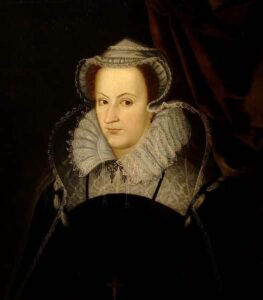
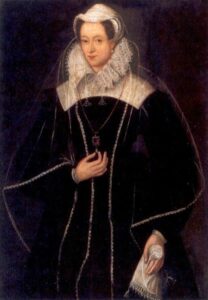
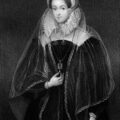


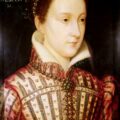
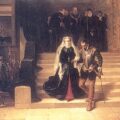

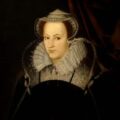

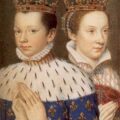
Jenny has asked me to post her thoughts on Mary Queen of Scots from an email she sent me, here they are:-
Of the many women of the Tudor Epoch, the two that I feel most sorry for are Lady Jane Grey and Mary Queen of Scots – But for this point, I will concentrate on the latter,
Everyone will have to forgive me as I am writing from memory in my office where I have no access to my books.
I think I have spoken before about the ”Gold and Silver children”. The “Silver” children (example Elizabeth 1) tended to have a hard childhood but that stood in good stead as years went by. The “Gold” children , on the other hand, had a relatively easy youth but were unable to cope with problems as time went on.
I see Mary as the latter.
Marys’s father married twice, both to Frenchwomen. The first died shortly after the marriage and then he was wedded to Mary of Guise who, as a widow with a son, had attracted H8, but before anything could come of the offer, she was well ensconced in Scotland.
She gave James V two sons who after some years died very shortly within the space of time and as James and H8 were always ready to get at each other, gave birth to a daughter, Mary, two days before James died at the battle of Flodden Field. He is supposed to have said about the Stewart (Scots style)/Stuart (French style) dynasty “It started with a lass and will end with one” .
H8 wanted Scotland and as time went on and he finally got a son by Jane Seymour, he tried to forcibly organise the marriage between his son, the future Edward VI and the young Mary.
As her mother was from a very high powered French family (The Guise) and the Scottish regime was still, in theory Roman Catholic, Mary was sent to France with the idea of espousing her in the future to the Dauphin. France is where she spent her childhood and where she was dreadfully spoilt.
She was highly educated but indoctrinated into the Roman Catholic way of thinking. On her marriage at 16 years old to the Dauphin Francois, she did secretly sign papers saying that in the event of no children being born of the union, the crown of Scotland would pass to France. (Novel – “Checkmate” by Dorothy Dunnet and other sources)
However, by that time the new learning of the Protestants had taken hold in Scotland.
Mary did become Queen of France but for an extremely short time (a year?) .
She seems to have alienated her mother in law, Catherine of Medici, as she was sent back to her place of birth. Somewhere she had not known for years and which was much poorer that the land of her adoption.
She was still young, full of “joie de Vive” and on the look-out for another husband. Her Catholic faith seemed to be constant but she was being made to accept the Protestant form of worship as well.
Her grandmother, Margaret Tudor, had married twice – first to James IV and then to Archibald Douglas by whom she has a girl child, Margaret.
Margaret Senior seemed to put her foot in it a number of times and had to escape with daughter to her brother’s court in England, that of Henry VIII.
Daughter, after various “adventures” was married of to the Earl of Lennox, a Scottish renegade, by whom she had two living sons, one being Henry Darnley.
The question is who arranged or not, his escape from England to Scotland? But there he went. According to my Scottish sources when I was on one of my many visits there, Mary had two huge probs., that of being over 6 ft. tall (which is those days was exceeding high for man or woman) and that she had a hair-lip which is only seen in the “Orkney Portrait of Mary Queen of Scots” held at Dunrobin Castle near Inverness.
Henry Darnley had the charm and the height and so persuaded Mary to marry him with the idea that he would become King of Scotland.
However, he had been a spoiled brat and an ideal husband for Mary in the eyes of the English Court as he had no ideas about responsibility.
Although he was most probably unfaithful to Mary from the start (with both sexes), he managed to impregnate her. However, his way of living became wilder and wilder. At almost full term Mary was forced to witness the slaughter of her secretary, David Riccio, at the hands of Darnley’s supporters. But she did give birth to a healthy son, James.
The couple were completely at odds – It is said that Darnley was suffering from syphilis – but in any case although words were said, it was sure that the marriage was over. On a night where the couple were supposed to have met to resolve their differences, Darnley was killed, supposedly by an explosion at the palace he was staying at, but his body was found outside in the grounds. Who was responsible????????
Not so long afterwards, Mary was supposed to be captured and raped by Lord Bothwell whom she subsequently married. However, this event was not welcomed by the Scottish parliament nor the Lords and both were hounded. Bothwell was caught and imprisoned although he did escape to Denmark where he met the same fate (and died there) and Mary fled to England thinking she was be supported by her cousin, Elizabeth.
For reasons unbeknown, but probably on the advise of her council, Elizabeth did not want to meet her cousin face to face and for a number of years, Mary was shunted around castle after castle or palace.
Was Mary really as beautiful as novels make out , therefore making Elizabeth jealous of her, or was the fact that the North of England was still highly Catholic, that lead to the various plots against Elizabeth.
I am also sure that Walsingham, a fanatical protestant, had more than one hand in the ways things were going.
But, everything points to the fact that Elizabeth was very much against putting a fellow sovereign to death – so why did she finally give way, sign the warrant and give it to Davison only to afterwards to imprison him? (Another novel “Unicorn’s Blood”)
In the end, the protestants had their way. Mary’s son, James was bought up as one and succeeded Elizabeth.
Interesting theories, so here’s another! Mary Stewart was drop-dead gorgeous, no hairlip! Eliz. was not jealous of her beauty–but her threat to power! Mary was the rightful heir to the throne of England as well as Scotland and France. Catherine De Medici was Queen Dowager, King Francis’ mother and she wanted Mary out of the way and to seal Scotland as another Catholic relm for France. Mary was to be a puppet Queen for France, controlled by the Dowager Queen and her corrupt Catholic uncles who had great power in the oppressive church of that time. remember her uncles tried to marry her off to all kinds of alliances so France could control England as well as Scotland. And Eliz.?? she was the illegitimate daughter to King Hviii and Anne Bolyn’s true daughter. Which she covered well throughout her illegitimate reign. So Mary, rightful Queen of 3 countries, raised to be totally void of all things pertaining to governance, was to be controlled by France and the Catholic church. Her mother, Mary of Guise, self-appointed Queen Regent of Scotland, was a lying manipulator with allegiance only to France, never to Scotland. Thus Mary posed a great threat to Elizabeth when she did not die in prison, but attempted multiple escapes, nor did she acquiesse to Elizabeth as HER Queen, so Eliz. had to get her out of the way and had her murdered as a traitor/treason on trumped up charges. Why else would her secretaries bawl pitifully, the executioner beg her forgiveness, as a calm Mary exclaimed “Sweet Jesus” raising her head as the first blow of the ax struck her, then a second blow required to actually behead her.???? Mary was quite the unwilling pawn, very intelligent, bewildered, used by many. She was utterly confused by Catholicism vs. Reformer “heretics” like Knox. She clung to her misguided faith and her belief that she was the Queen of 3 countries, though purposefully ill-equipped/educated to govern.
What I find hard to believe is that James 1st was the son of Darnley because the portraits don’t show any resemblance between the two, also Mary was five feet eleven inches and Darnley about the same and two tall parents tend to produce tall offspring, Antonia Fraser writes, in appearance James was very unlike his tall and godlike parents, Darnley looks very insipid and very thin, not muscular at all and Mary was praised for her beauty though her portraits don’t exactly show her as such, James was said to be about five six which in Tudor times wasn’t short really but when you consider how tall his parents were it sounds strange, although Mary’s father was of medium height, I think the real reason Elizabeth didn’t want to meet Mary was because she might feel sympathy towards her and might weaken in her resolve to keep her imprisoned, they were after all cousins and Mary was known to be very charming maybe Elizabeth couldn’t risk meeting her in case she ended up growing quite fond of her, her advisors also probably was against it too I think Elizabeth was intrigued at the thought of Mary as one does towards a relative theirve never met, she asked the Scottish ambassador a lot of questions about her personal appearance, can she play the lute and dance well, how tall is she etc, these questions show a natural feminine curiosity about her young rival, it’s very sad that being both Queens they couldn’t become friends the way that cousins should be.
…”Queen, so Eliz. had to get her out of the way and had her murdered as a traitor/treason on trumped up charges. Why else would her secretaries bawl pitifully, the executioner beg her forgiveness”…
This, I totally agree with. Not to mention, Elizabeth, claiming after she signed the death warrant that she didn’t give the go ahead. That was a bald faced lie. Anyone knows that if it was carried out without her consent, she would have had those who carried it out executed.
She gave the order to execute her then didn’t even have to guts to own up to it. Pretty cowardly.